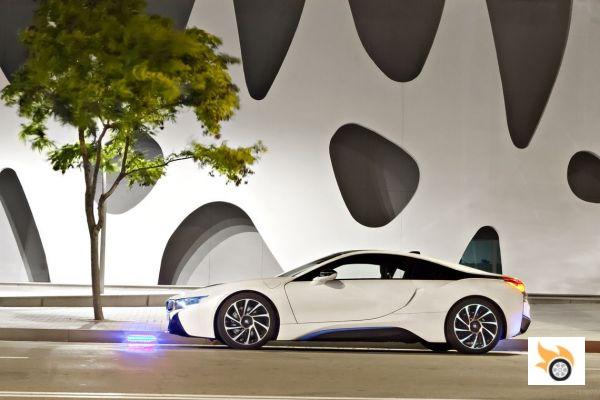
The BMW designers didn't fall asleep on their graphics tablets. On the contrary, they must have been smoking
A few weeks ago BMW let us for a few (very) few days a unit of this spaceship that they sell under the name of BMW i8 (of which 2,135 have been sold in the world; 25 in Spain and this year BMW expects to double sales). The car is futuristic, no doubt, but it is also beautiful (at least, for me) and its physiognomy is aerodynamic, as it boasts a Cx of 0,26. I will not expand on its appearance, we've all seen it a thousand times and it has been explained ad nauseam that its forms are also functional or how the air is channeled above the rear lights to pass under the two fins of the engine hood and thus provide aerodynamic support. This time, it's not so much a matter of deciphering the i8's technique as seeing if, for those looking for a GT, BMW's proposal is relevant in real life.
Its proportions are those of a mid-engined supercar: 4.70 m long by 1.29 m high by 1.94 m wide. In the BMW car park, the i8 looks like it's arrived from another planet, unless all the cars in the windows are classics. Ah, well no, they're new models... The door opens almost vertically, which adds a bit more solemnity to the affair, and I finally drop into the trunk, after stepping over the carbon fiber threshold. Yes, it's a bit wide, but much less than that of a Lotus Exige.
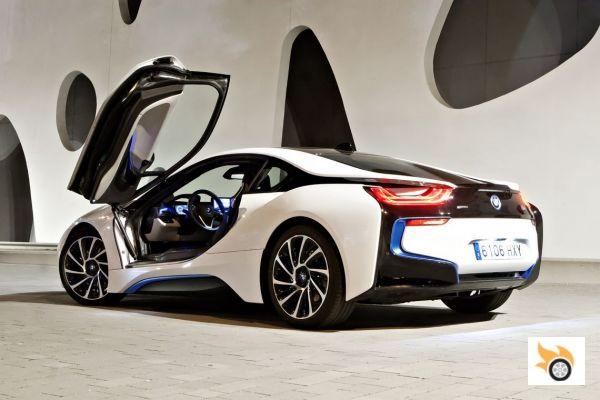
On board
After dropping into the enveloping trunk, I'm confronted with a dashboard that, while it doesn't break the established rules of ergonomics, is yet another example of the overflowing creativity designers have when they're allowed a certain amount of freedom. The dashboard is clearly oriented towards the driver, separating him from his co-driver, but instead of surrounding the driver the shapes of the dashboard are an invitation to drive.
The steering wheel and the two side air vents seem to emanate from the instrument panel, like open arms inviting the driver to start the car and hit the road. But before doing so, I savour the moment, checking the i8's quality finish. It's true that some elements, such as the radio, climate controls and iDrive could very well be those of a 1 Series, but the rest of the cabin is of exquisite quality: from the aluminum of the air vents, to the dashboard leathers and the blue contrast stitching. The leather of the seats, meanwhile, is more technical than luxurious.
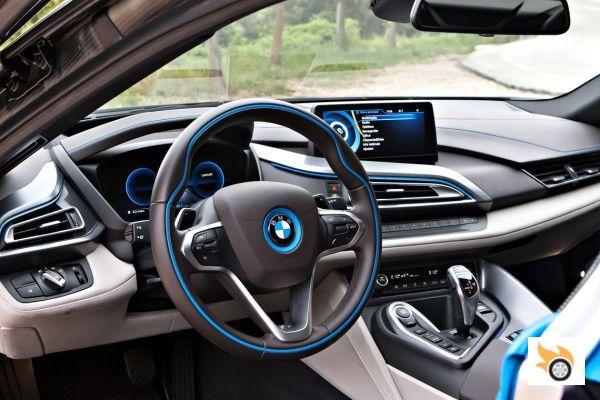
The steering wheel and the two side air vents seem to emanate from the instrument panel, like open arms inviting the driver to take to the road.
The driving position is simply ideal, as it could not be otherwise in a sports car of this caliber. In terms of habitability, an Audi R8 offers more space and height in the passenger compartment. As for the two rear emergency seats, are identical to those of a 911. That is, for use in a timely manner no more than 20 minutes for passengers, and always as a complement to the trunk (lying the backs of the seats that form a uniform load plane). In the case of the i8 it is not a luxury. The trunk has the capacity to hold a photographer's backpack (and not the big ones), the charger and a couple of triangles. And that's it. Yes, on a practical level that's what the 154 litres of boot space means.
Genuine BMW
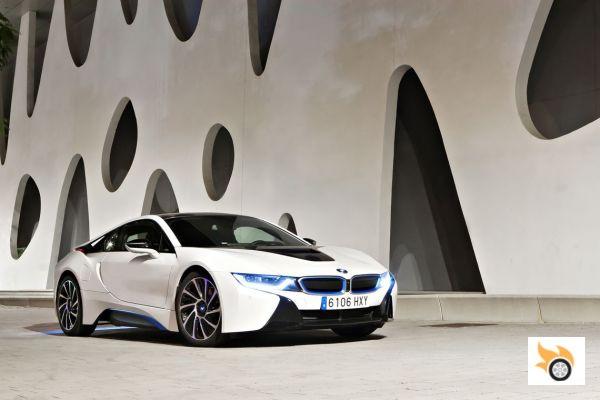 With the key in hand, I press the Start button. Nothing. Or almost, the dashboard lights up and we see everything in blue, because Comfort mode is the car's default setting (later, when selecting Sport, everything will turn red). As with all hybrids, first the electric system kicks in and it's the electric motor that moves us out of the parking lot. Here the BMW fanboys will start to criticize the car for not having an inline 6 cylinder, for its electric motor making it front wheel drive, because it has a measly 3 cylinder, and so on. Let's take it one step at a time. First of all, it's the first mid-engined BMW since the legendary M1. Then, its mid-engine is effectively a 1,500cc turbocharged three-cylinder, but it develops more than 150bhp/litre. Incidentally, this engine has been awarded the "International Engine of the Year Award 2015". And to finish, its electric motor located on the front axle serves for more than just moving noiselessly, as it develops 131 hp. In the end, the BMW i8 delivers 362 hp. And this is already starting to be interesting, especially when we remember that the lithium-ion batteries are located in the central tunnel of the car, which means an extremely low center of gravity. And since the main engine is in a central position, the mass distribution couldn't be more optimal (50/50). On paper everything indicates that it is designed to have a good time from corner to corner.
With the key in hand, I press the Start button. Nothing. Or almost, the dashboard lights up and we see everything in blue, because Comfort mode is the car's default setting (later, when selecting Sport, everything will turn red). As with all hybrids, first the electric system kicks in and it's the electric motor that moves us out of the parking lot. Here the BMW fanboys will start to criticize the car for not having an inline 6 cylinder, for its electric motor making it front wheel drive, because it has a measly 3 cylinder, and so on. Let's take it one step at a time. First of all, it's the first mid-engined BMW since the legendary M1. Then, its mid-engine is effectively a 1,500cc turbocharged three-cylinder, but it develops more than 150bhp/litre. Incidentally, this engine has been awarded the "International Engine of the Year Award 2015". And to finish, its electric motor located on the front axle serves for more than just moving noiselessly, as it develops 131 hp. In the end, the BMW i8 delivers 362 hp. And this is already starting to be interesting, especially when we remember that the lithium-ion batteries are located in the central tunnel of the car, which means an extremely low center of gravity. And since the main engine is in a central position, the mass distribution couldn't be more optimal (50/50). On paper everything indicates that it is designed to have a good time from corner to corner.
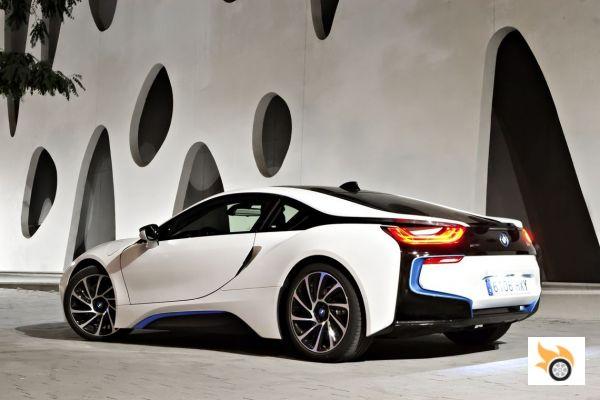
Its central turbocharged 3-cylinder produces more than 150 hp/litre. With the electric motor, that's more than 360 hp at its disposal.
Before we hit the curves of my usual mountain stretch, we'll check out how the i8 handles in an urban environment. After all, it's a plug-in hybrid that would allow us to drive around town in 100% electric mode. The battery level indicates that it's at full, which translates into a range of 25 km. The ultra-light steering and the limitless flexibility of the electric motor (250 Nm at all times) make getting around town a breeze. If it weren't for a left A-pillar that I find a bit too thick at times (it can easily hide a pedestrian) and a very limited rear three-quarter visibility (the blind spot mirrors should be a bit bigger), getting around in the i8 would be just as easy as in the i3. However, in terms of electric range, the i8 can't rival its little brother. The 25 km advertised by the on-board computer were not met. In reality, depending on the terrain and type of driving, the range is around 17 km. Let's face it, even in the city, with an i8 you're not going to be hypermiling, looking for the lowest possible fuel consumption. There's a gap in the traffic jam, you get in at lightning speed. The light turns green, and you leave all the scooters and maxi-scooters in the city behind (except for that fly c**** that is the T-Max).
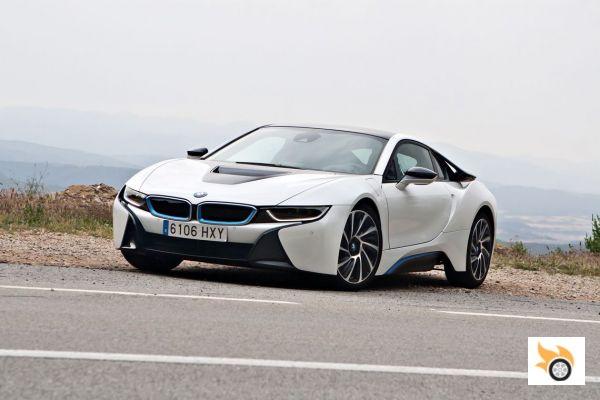
When you leave the city, to recharge the battery, you switch to Sport mode. And there the engine wakes up. Finally we hear it. Or rather we notice its presence, as long as we pay attention. At constant speed, at 2,800 rpm (about 130 km / h of marker) you can hardly hear it. To wake up the 3-cylinder, you have to put your right foot on the accelerator or switch to manual, pulling the left cam, for example, or pushing the knob to downshift. In this case, the i8 becomes a real car again. Climbing up to 7,000 revs, the 3-cylinder doesn't burst your ears, it just starts to sing. It has a strange, genuine three-cylinder chirp, more akin to a fat V6 than the howl of an inline six. It's a most pleasing sonority and for a while you end up revving just for the pleasure of listening to it.
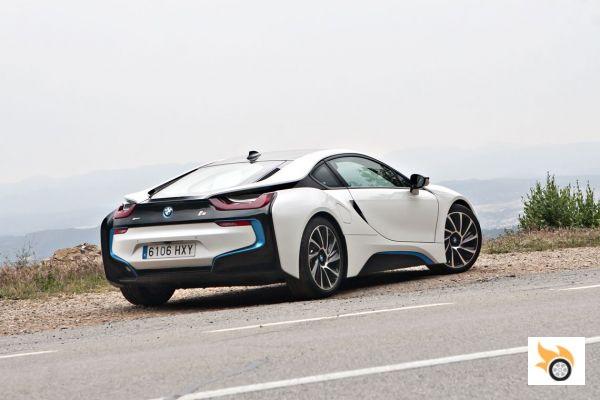
Despite its power deficit, the i8 accelerates like a 911 and recovers better than an M3 DKG.
It's not just nice sounding, it's also efficient. The turbo, which we don't hear, isn't just there as an anonymous extra in this film: it blows. And a lot of it. Up to 1.7 bar, to be exact. Normal, for a 1,499 cc to deliver 231 hp it needs a "fat" turbo. There's another engine that we don't hear about to the point that we could forget about it: the front electric motor. And since the grace of electric motors is to deliver all its torque continuously, 250 Nm in this case, the BMW i8 thus has the luxury of being able to accelerate like a Porsche 911. In fact, despite delivering just 362 bhp - compared to 430 bhp in the 911 Carrera 4S - the i8 can do 0-60 mph in 4.2 seconds, compared to 4.1 seconds in the 911. Impressive. In terms of performance, the i8 remains at heart-stopping levels with a 400m from standstill in 12.3secs (12secs for the 911) and a 1,000m from standstill in 22.8secs for the i8, compared to 22secs for a 911. It's worth noting that the 911 reaches these marks at a much faster pace and that it continues its acceleration until it can reach 300 km/h when the i8 loses steam as it approaches 250 km/h (its top speed). In recoveries, the i8 also stands out for its excellent result. It needs only 3.2 seconds to go from 80 to 120 km/h in Drive (with Sport mode activated); 0.3 seconds better than a 431 hp M3 DKG.
Behind the wheel
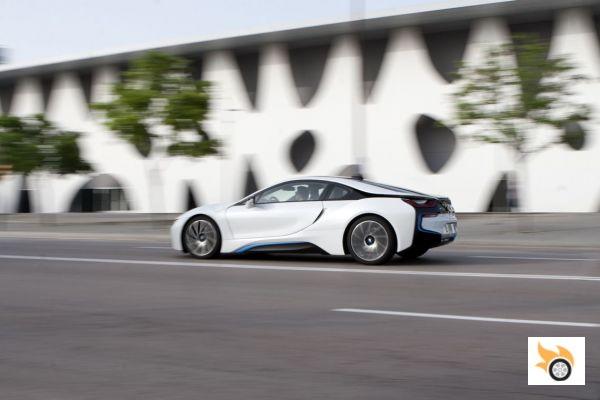 Performance isn't everything, it's also about feel. Yes, the i8 is a hybrid and no, it's not boring; on the contrary. Its dynamic behaviour is very pleasant, although a bit disconcerting in terms of sensations. Mainly because of a totally aseptic steering; it doesn't transmit anything at all. It's a very stiff car and designed to be very precise. Its architecture, its rigidity (carbon fibre and aluminium structure with plastic bodywork) and its balance (50/50 weight distribution) make it a real BMW in its behaviour, which without being that of a pure sports car is that of a very incisive grand tourer. The stability is overwhelming, the changes of turns are made at the speed of light -although you have to rely on the view and the ass to feel the car, because we will not feel anything through the hands-.
Performance isn't everything, it's also about feel. Yes, the i8 is a hybrid and no, it's not boring; on the contrary. Its dynamic behaviour is very pleasant, although a bit disconcerting in terms of sensations. Mainly because of a totally aseptic steering; it doesn't transmit anything at all. It's a very stiff car and designed to be very precise. Its architecture, its rigidity (carbon fibre and aluminium structure with plastic bodywork) and its balance (50/50 weight distribution) make it a real BMW in its behaviour, which without being that of a pure sports car is that of a very incisive grand tourer. The stability is overwhelming, the changes of turns are made at the speed of light -although you have to rely on the view and the ass to feel the car, because we will not feel anything through the hands-.
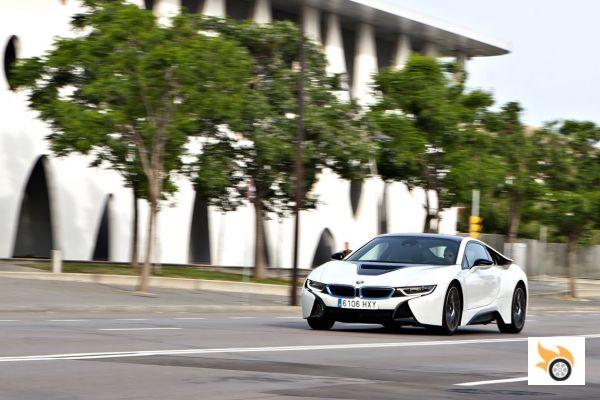
Balanced, ultra-stable and grippy: the i8 is efficient without being playful.
If we pick up the pace, a slight understeer appears, but I insist it's very light. On corner exits, if we put our foot down too much, the rear will start to slide very slightly but almost instantly the front engine will kick in to transfer the excess torque to the tarmac and we'll return to the initial trajectory. It's not a car you're going to have fun with if you like rallying - for example, it's very difficult to put it in the corner with the brakes, not to say impossible - it's more a car for "obsessive compulsive", that is, for people who like circuit laps and who always look for the cleanest possible trajectory. For them, the i8 will be a very efficient toy, but not necessarily fun. And let's not forget, it's a grand tourer, not a sports car. In addition, the i8's automatic transmission, while not one of the slow ones, is not a dual clutch, nor is it the 8-ratio ZF that the brand usually uses. It's the 6-speed automatic transmission from the MINI Cooper S, which puts it definitively in the GT category and not the sports car category. As for the damping, the i8 uses a continuously variable combination that is somewhat firm in compression, but still guarantees excellent on-board comfort.
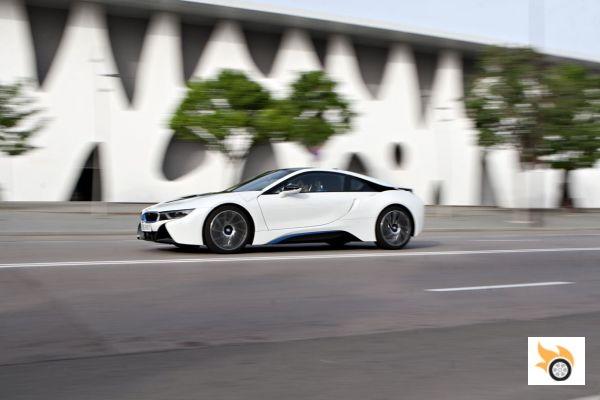 On the motorway, the car is refined except for some aerodynamic noise; we are travelling aboard a luxury grand tourer. The steering becomes lighter and even under acceleration we notice how the nose lightens a bit (in the style of the old Porsche 911), but the car's poise is overwhelming. The Autobhan curves at 200 km/h are negotiated as if you were in an AVE, you even end up thinking that you're really on rails. This stability is due more to the heavy battery pack in the centre tunnel than anything else, even more so than the aerodynamics. The narrow tyres are certainly not the cause of the stability and grip. In our test car we had the option of "wide" tyres (215/45 R20 at the front and 245/40 R20 at the rear)?
On the motorway, the car is refined except for some aerodynamic noise; we are travelling aboard a luxury grand tourer. The steering becomes lighter and even under acceleration we notice how the nose lightens a bit (in the style of the old Porsche 911), but the car's poise is overwhelming. The Autobhan curves at 200 km/h are negotiated as if you were in an AVE, you even end up thinking that you're really on rails. This stability is due more to the heavy battery pack in the centre tunnel than anything else, even more so than the aerodynamics. The narrow tyres are certainly not the cause of the stability and grip. In our test car we had the option of "wide" tyres (215/45 R20 at the front and 245/40 R20 at the rear)?
With or without juice
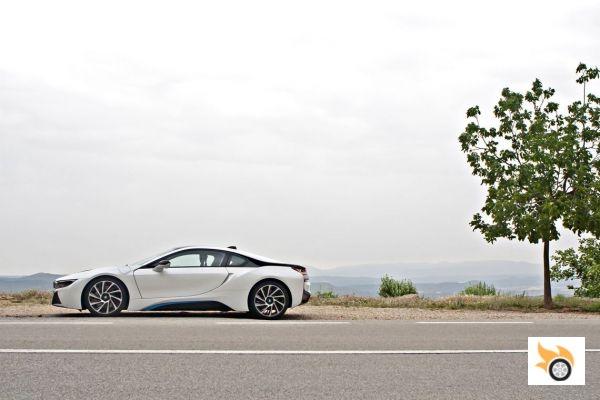 I was particularly interested in testing the i8 because it could be an answer to the immediate future of mobility. We already knew that a hybrid could be sporty and enjoyable, with the BMW i8 we have first-hand confirmation, and now it remains to see how hybridization works and what it brings in terms of consumption.
I was particularly interested in testing the i8 because it could be an answer to the immediate future of mobility. We already knew that a hybrid could be sporty and enjoyable, with the BMW i8 we have first-hand confirmation, and now it remains to see how hybridization works and what it brings in terms of consumption.
The figures prove it, the i8's performance is no mean feat. In terms of sensations, they don't let you down either, however it has to be said that in sporty driving, once you've drained the battery, you're left with much less power than you expected and the nose becomes a little heavier than before, which doesn't help your driving enjoyment.
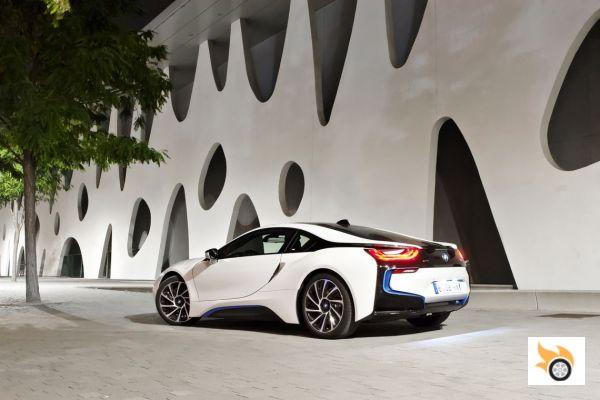
To enjoy its full potential it's essential to have a full battery, otherwise it's like running out of dessert.
You make your passes (or your pass, depending on its length) through your favourite mountain pass and at a certain point you run out of battery. The central computer then warns you to be careful, as you are now driving a rear-wheel drive car ("propulsion", as indicated on the car). Acceleration is no longer as intense (it is indeed slower, you lose more than 2 seconds in the 0 to 100 km/h) and the car suddenly seems much heavier. In terms of weight, you go from feeling like you're driving a Z4 to a 5 Series. The handling is also changed, with a slightly more sluggish nose when cornering. So does it get boring? Not at all, it's like driving a mid-engined Golf GTI. In fact, the power available to you is similar: 231 hp. But because you've been enjoying the benefits of electric power until now, the turbocharged 3-cylinder is not enough. The solution then is to go back down the mountain pass abusing the brakes - which seem indestructible (unusual for a BMW and noteworthy) - to recharge the battery. Or, if you've had enough, you return home and in 20 km of highway you recover between 8 and 10 km of autonomy. Personally I opted for the latter option, as I still had to take the photos that accompany these lines.
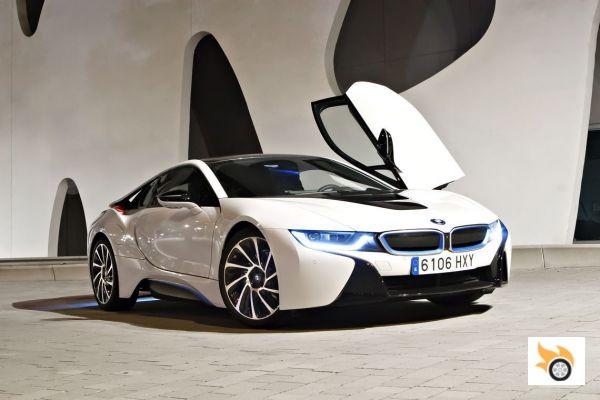 And the consumption? At the end of the test, I ended up with an average of 8.3 l/100 km. Far from the funny European homologated average consumption of 2.1 l/100 km, the real consumption of the car does not cease to surprise me, in a positive way. Let's remember that it's 362 hp with Porsche 911 performance -much more powerful- and it's allowed to give it a slap in the face in terms of consumption, as the 911 Carrera 4S averages around 12 l/100 km in real terms. The i8 is for me, a real technological feat that provides an answer to the immediate limitations of CO2 emissions. And it does so with stunning beauty and verve that's fun to drive. It's the car of tomorrow, available at dealerships today.
And the consumption? At the end of the test, I ended up with an average of 8.3 l/100 km. Far from the funny European homologated average consumption of 2.1 l/100 km, the real consumption of the car does not cease to surprise me, in a positive way. Let's remember that it's 362 hp with Porsche 911 performance -much more powerful- and it's allowed to give it a slap in the face in terms of consumption, as the 911 Carrera 4S averages around 12 l/100 km in real terms. The i8 is for me, a real technological feat that provides an answer to the immediate limitations of CO2 emissions. And it does so with stunning beauty and verve that's fun to drive. It's the car of tomorrow, available at dealerships today.

























